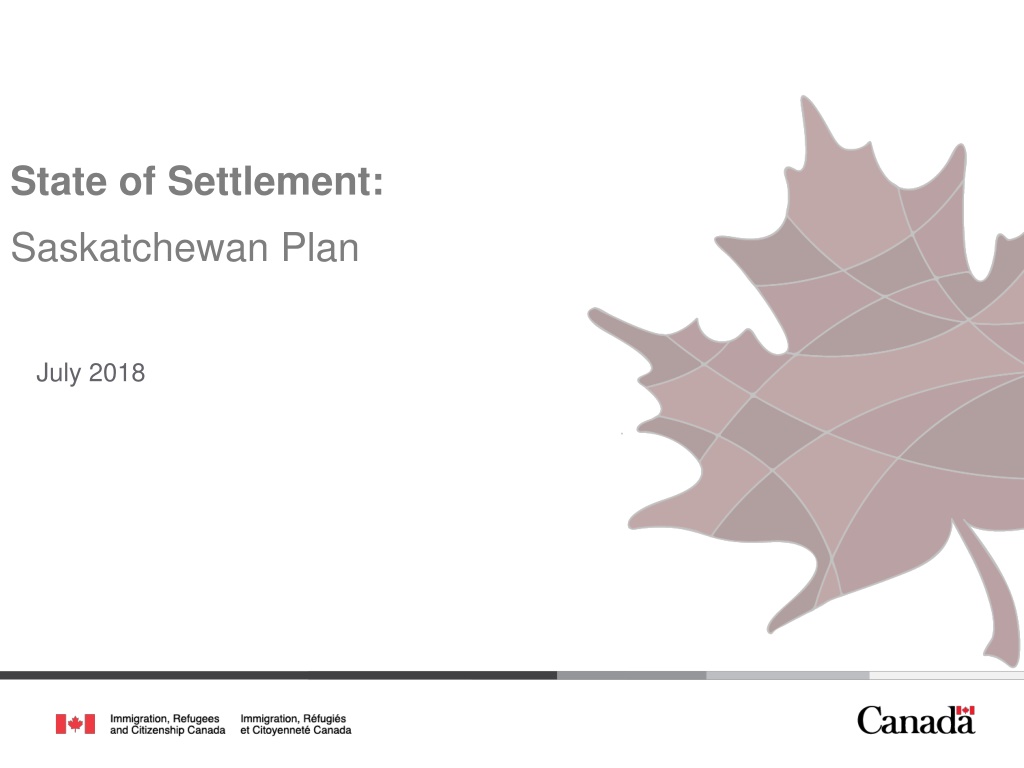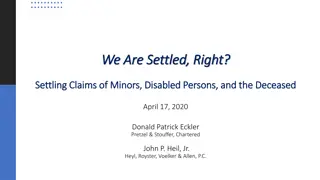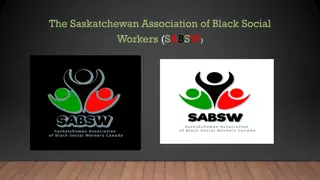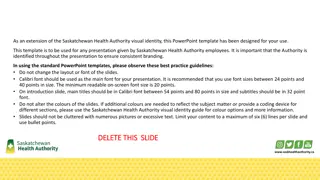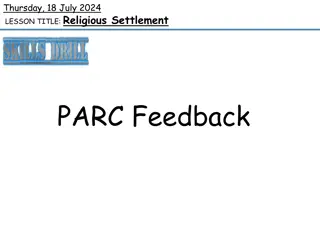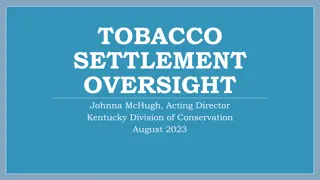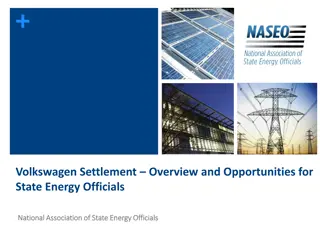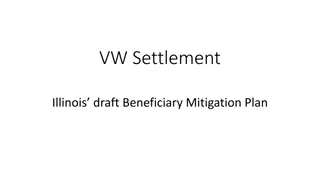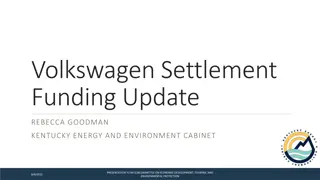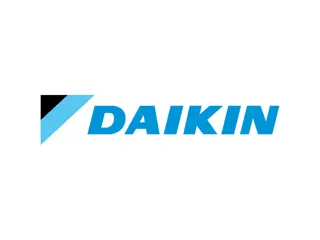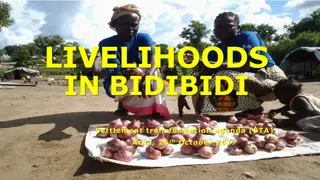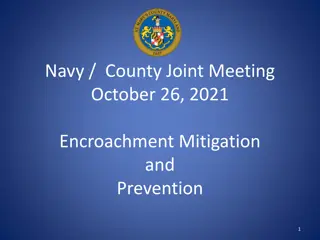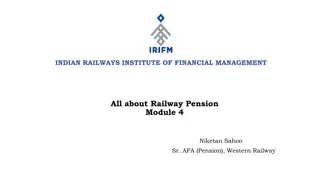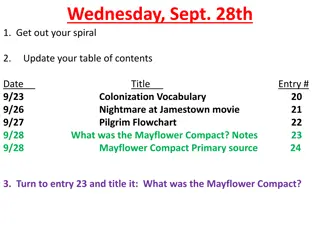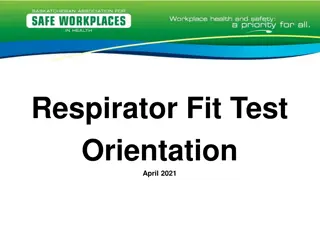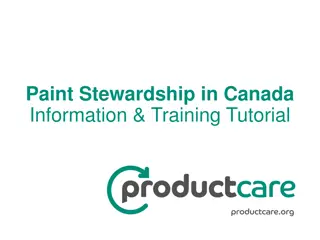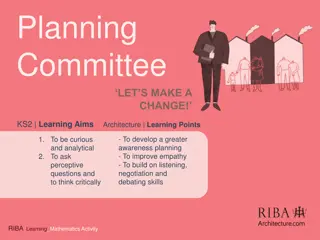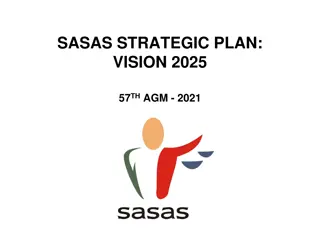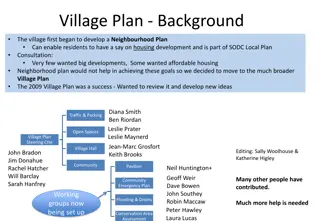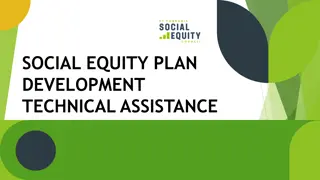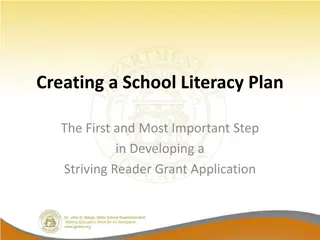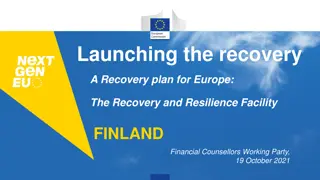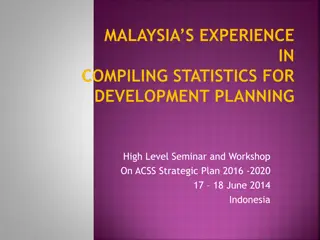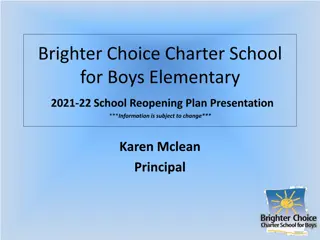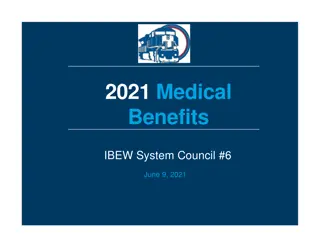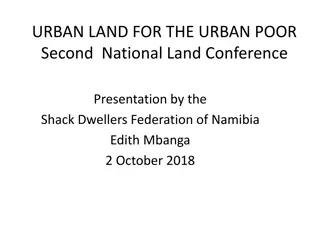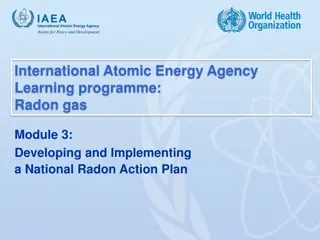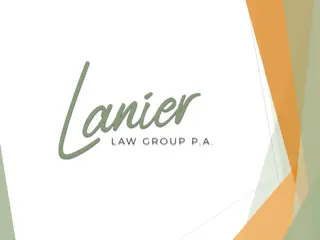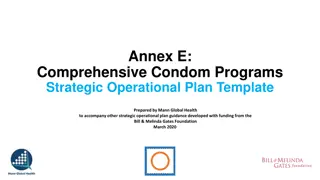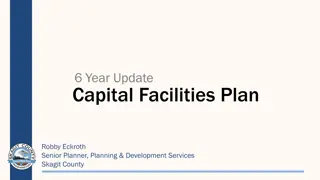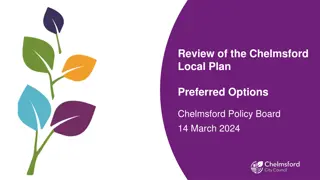Comprehensive Plan for Settlement and Development in Saskatchewan
The document outlines the state of settlement efforts in Saskatchewan from July 2018, focusing on building evidence, region development, capacity building, partnership enhancement, transparency, coordination, and client-driven investments. It delves into service mapping, community context, language training, funding breakdown, resettlement assistance programs, and potential gaps, backed by research and conference reports. Efforts are made to enhance transparency, identify priorities, and strengthen partnerships with the government for effective settlement strategies.
Uploaded on Sep 14, 2024 | 0 Views
Download Presentation

Please find below an Image/Link to download the presentation.
The content on the website is provided AS IS for your information and personal use only. It may not be sold, licensed, or shared on other websites without obtaining consent from the author. Download presentation by click this link. If you encounter any issues during the download, it is possible that the publisher has removed the file from their server.
E N D
Presentation Transcript
State of Settlement: Saskatchewan Plan July 2018
Outline State of Settlement Building the Evidence Building the Region Building Capacity and Partnerships Enhancing Transparency Enhancing Coordination, Cooperation and Collaboration Client-Driven, Outcomes-Focused Investments 2 2
Outline (contd) Service Mapping Community Context Urban & Small Center Service Areas Regional Context Language Training and Assessment Breakdown of Recommended and Currently Funded Services Resettlement Assistance Program Summary of investment Potential Gaps 3
Building the Evidence Base Immigrant Research West Western Canadian Settlement Experience Survey http://umanitoba.ca/faculties/arts/research/media/Western_Canada_Settlement_-_2013.pdf Settlement Services in Western Canada: Results from 29 Rural and Small Centers http://umanitoba.ca/faculties/arts/research/media/RDI_Settlement-Western_New-Glasgow- Sept-9.pdf Data Mapping of Newcomers to the West https://gistest.usask.ca/irw/ Longitudinal Survey of Syrian Refugee (Re)Settlement in PNT http://umanitoba.ca/faculties/arts/media/revised_Oct19_FINAL_REPORT_JUNE_27.pdf 10 Years of Francophone Settlement Experience in the West http://legacy.aaisa.ca/wp-content/uploads/2016/07/Paulin-Mulatris.pdf PNT Small Centre Learning Event June 26-28 2017 report Promising Practices http://mansomanitoba.ca/resources/prairie-northern-territories-small-centre-promising- practices-learning-event-report-2017/ 4
Building the Region Western Canada In School Settlement Conference (February Calgary 2013) Building the New West Conference (March 2013) Western Dialogue Group (2013-2017) Connecting PNT LIPs and RIFs PNT Clusters (2016-) Small Center Learning Event Final Report (Brandon-2017) http://gcdocs2/otcs/cs.exe/open/210315563 5
Building Capacity Internal Phase 1 (Comparisons across region) Phase 2 (Structural change) External Investing in the Sector Investing in Community Engagement Working with the Government of Saskatchewan 6
Enhancing Transparency: Identifying Priorities and Pressures 2014-15: Settlement Plan & Summit 2016: Amendments Call Out Process 2016-17: Calls, Dashboards and Lessons Learned Event 2017-18: Service Mapping, Quarterly Calls, Integration Summit 2018-19: Service Mapping, Quarterly Calls, Integration Summit, Co-planning, 7
Enhancing Coordination, Cooperation and Collaboration Biweekly calls between provincial and federal officials Quarterly face-to-face meetings between provincial and federal officials Extensive collaboration on language programming following results of provincial audit Ongoing joint work to align language assessment and to develop/implement a made-in-Saskatchewan approach to on-line language learning Joint work at the local community level to align investments Continued analysis of how provincial investments in Gateways and settlement advisors aligns with IRCC investments Joint work to encourage language-labour market pilot projects 8
Community Context Saskatchewan - Urban & Small Centers - In May 2015, the Rural Development Institute at Brandon University conducted a research project to map out the immigration settlement services and gaps in rural Saskatchewan. Results of the research confirmed the challenges of settling newcomers in a rural setting versus those who choose to live in larger urban centers - In 2016 we began to develop a small center strategy which will be complete in 2018 in time to inform priorities for CFP 2019 - This strategy was developed to ensure that clients in non-urban areas would have access to quality settlement and language programs, and that the needs of service provider organizations could be addressed based on their unique community contexts - Major Urban Centers in Saskatchewan have been defined as Saskatoon and Regina 9
Community Context - Small center areas were mapped in 5 zones across the province to ensure settlement and language programs are available to all permanent residents outside of Saskatoon and Regina. - The Provincial Gateways are included in each zone, to ensure IRCC funding will complement existing community services and not duplicate them. Each zone will host a suite of language and settlement programs to address the unique newcomer needs in those communities. - Consultations with the Government of Saskatchewan confirmed that zone divisions are not consistently applied across provincial ministries in measuring user access. - The catchment area of service delivery used by IRCC is therefore representative of the zones used by the Regional Colleges and the Provincial Gateways. 10
Community Context Tier 1: Smaller Communities Pop. up to 10,000 and/or 20+ landings and/or unique clients in iCARE for 2016/17 Tier 4: Major Urban Centers Complex Settlement Eco- System Tier 3:Medium- sized Cities Full Suite of Settlement Services Tier 2: Small Cities Pop. 10,000 to 35,000 and/or 50+ landings and/or unique clients in iCARE for 2016/17 Tier 2: Small Cities Basic Settlement Services Available Tier 3: Medium-sized Cities Pop. 35,000-150,000 and/or 200+ landings and/or unique clients in iCARE for 2016/17 Tier 1: Small Communities Minimal Settlement Services Tier 4: Major Urban Centers Pop. Over 150,000 and/or 1000+ landings and/or unique clients in iCARE for 2016/17 11
Service Levels by Community Size Tier 1 Small communities Services: Minimal settlement services Conversation circles, remote delivery, community connections, informal Information and Orientation services, Settlement Workers in Schools (SWIS), Home Instruction for Parents of Preschool Youngsters (HIPPY). Tier 2 Small cities Services: Basic settlement services Need Assessments and Referrals (NARs), Information and Orientation, SWIS, LIPs, language training and community connections Tier 3 Medium-sized cities Services: Full suite of settlement services Multiple providers, NARs, Information and Orientation, SWIS, language training with at least one provider at higher CLBs, language assessment, LIPs and community connections Tier 4 Major Urban Centers Services: Complex settlement eco-system Full suite of services, including Local Immigration Partnerships (LIPs) and specialized services for vulnerable populations. 12
Urban Center Zones Tier 4 Saskatoon Regina 13
IRCC Community Typology *Zones Tier 1 Tier 2 Tier 3 Saskatchewan North West Biggar Kindersley Rosetown North Battleford North Central Warman Prince Albert North East Annaheim Humboldt Melfort Tisdale South West Gull Lake Maple Creek Ponteix Swift Current Moose Jaw Estevan Weyburn Yorkton South East Esterhazy Watrous Wynyard 15 *Zones are Gateways Of Saskatchewan-cited from province of Saskatchewan website
Zone Context - The Province of Saskatchewan provides funding in three specific areas of settlement: o Regional Gateways o Settlement Advisors o Stage 1 and 2 language via regional colleges - IRCC co-funds most Gateways and language training at regional colleges - Working closer with the Province of Saskatchewan to align language program service delivery as per the Provincial Audit Report - Seeking opportunities to expand service delivery to include conversation circles and increasing access to online language training - Collaboration with language assessment centers to ensure consistency in conducting language assessments with an end result of establishing consistency and capacity 16
Language Assessment - Saskatchewan Prior to enrollment in a IRCC-funded formal language training program, newcomers must undergo a language assessment to ensure effective placement. In all 5 small center zones in Saskatchewan the assessment process is embedded in the language provider contribution agreement at the Regional Colleges and Moose Jaw Multicultural Council. In 2017-18 the Language Assessment and Referral Center (LARC) in Saskatoon started a pilot project to handle itinerant language assessments for language training clients of the YWCA in Prince Albert. Remote and itinerant assessments completed by the LARC will be piloted in other regions across the province pending evaluation of the success of the Prince Albert pilot. 17
Language Assessment Saskatchewan (contd) In Saskatoon and Regina, all language assessments are provided through a single service provider organization, and referrals to language training are determined by the client with guidance from the center to ensure the clients needs are met and barriers to training are removed whenever possible. International Women of Saskatoon operates the Language Assessment and Referral Center (LARC) in Saskatoon and Regina. As the single center of expertise in language assessment in Saskatchewan, they coordinate training for all assessors in the province, host recalibration sessions and facilitate language advisory councils in both centers with representation from all funded language providers in Saskatoon and Regina. This approach has provided consistency in the quality of assessments in both centers, and closed a service gap in Regina that had become apparent in recent years. 18
Language Assessments Urban Centers Saskatchewan Unique clients (Apr 1- Mar 31, 2018 actuals) Unique Clients (Apr 1, 2018 May 31, 2018) Projected language assessments over 3 years (2017-2020) 2017- 2018 Projecte d Target % met as of March 31, 2018 2018-19 Target Met % to Date 2018-2019 Projected Zone Saskatoon 2,250 2,136 95% 2,250 354 16% 6,750 Regina 1,700 1,517 89% 1,700 238 14% 5,100 Total 3,950 3,653 92% 3,950 592 15% 11,850 International Women of Saskatoon provides all urban language assessments to Saskatoon and Regina 19 Client counts determined using SPO Location and 2018-19 service period fiscal year information pulled July 18, 2018
Language Assessments Small Centers Saskatchewan Unique clients (April 1 March 31, 2018 actuals) Target % met as of March 31, 2018 111% Unique Clients (Apr 1 May 31, 2018) Projected language assessments over 3 years (2017-2020) 2018-19 Target Met % to Date 2017- 2018 Projected 2018- 2019 Projected Zone North West *North Central 35 39 35 1 3% 105 67 63 94% 50 19 38% 186 *North East *South West *South East Total 115 120 104% 125 11 9% 365 136 146 107% 136 17 13% 408 150 169 113% 160 12 8% 470 503 537 107% 506 60 8% 1,515 * In 2017-2018 two organizations (one small center and one urban) provided assessments for North Central. In 2018-2019 language assessments will be provided by one Urban SPO. Targets and percentage of clients served in Small Centres are under review. Client counts determined using SPO Location and 2018-19 service period fiscal year information pulled July 18, 2018 20
Language Training - Saskatchewan Language training accounts for the bulk of IRCC investments in settlement services. The national average is approximately 40%. There are three primary means of service delivery: Formal classroom-based language classes guided by the CIC-funded Canadian Language Benchmarks (CLBs). Blended language training making use of technology to either entirely deliver language training-remotely, or combined with some in-person classes. Informal language training which is not pegged to the CLB-framework and is often managed by volunteers. The main remote delivery service offered by IRCC is LINC Home Study (LHS) which is managed through an Ontario-based service provider organization, through a CA held by NHQ. Presently, Saskatchewan is a major user of this service and will significantly expand services in rural regions. The SAISIA language working group, in consultation with rural language delivery agents will be exploring the potential of a Made in Saskatchewan online language delivery alternative to expand delivery options in rural Saskatchewan. While online learning may be the preferred method of language delivery in rural or isolated locations, accommodations will need to be built into any new model to address lack of band width or internet accessibility. Conversation circles are embedded in almost all of the proposals. Recommendations reflect a significant expansion in rural areas to increase flexibility and reduce costs. 21
Language Training Waitlists Saskatchewan (May 31, 2018) Lit CLB 4 All Lengths of Time CLB 5+ All Lengths of Time Totals Lit CLB 4 Over 60 Days CLB 5+ Over 60 Days Over 60 Days Totals All Lengths of Time Saskatoon 103 242 347 41 112 154 Regina 49 25 74 49 11 60 Moose Jaw 1 5 6 0 4 4 Totals 153 272 427 90 127 218 22
Language Training - Enrollment vs. Occupancy On the May 8th National Working Group on Language call, clarification was provided to distinguish enrollment vs. occupancy Enrolment (monthly): The number of IRCC-eligible clients enrolled in an IRCC-funded language training course for the given month (based on the information entered in iCARE or HARTs). E.g. if 10 clients are enrolled in a course with 10 IRCC-funded seats, the enrolment rate would be 100%. Numerator / Denominator *100% Numerator: # of client enrolled in the course (This is only for IRCC clients) Denominator: # of IRCC funded seats in the course Occupancy: The number of IRCC-funded clients who were formally enrolled and attended an IRCC- funded language training course for the given month (based on the information entered in iCARE or HARTs). E.g. if 10 clients are enrolled in a course with 10 IRCC-funded seats, but only 8 clients attended 100% of the time, the occupancy rate would be 80%. Numerator / Denominator *100% Numerator: Sum of the # of classes attended by all students in a month Denominator: # of IRCC funded seats in the course * # of classes conducted in a month 23
Language Training - Saskatoon Unique clients (April 1- March 31, 2018) # of Clients Enrolled* (as of May 31st, 2018) Funded Seats as of May 31st, 2018 Blended/On- Line/ Conversation Circles Average Occupancy Rate %** Language Provider Enrollment % Levels Offered Class room Saskatchewan Intercultural Association (SIA) Yes Target CC clients over 3 years = 96 CLB 1 - 8 744 351 328 107% 78% Yes Global Gathering Place (GGP) LINC Yes Target CC clients over 3 years = 576 Lit CLB 4 409 318 343 93% 66% Yes Saskatchewan Polytechnic (Saskatoon) LINC CLB 1- 9 858 905 850 106% 76% Yes No Saskatoon Open Door Society (SODS) Lit CLB 4 729 461 513 90% 74% Yes No Total 2,740 2,035 2,034 100% 74% IRCC will be working with SPO s to ensure they are accurately reporting occupancy in iCARE. *Enrolled client counts include all clients enrolled during the month, including those who have joined or left the course. **Average of occupancy rate for all courses offered 24
Language Training - Regina Unique clients (April 1- March 31, 2018) # of Clients Enrolled* (as of May 31st, 2018) Funded Seats as of May 31st, 2018 Blended/On- Line/ Conversation Circles Average Occupancy Rate %** Language Provider Enrollment % Levels Offered Class room Yes Target CC clients over 3 years = 1260 Regina Open Door Society Lit CLB 5 845 526 789 67% 56% Yes Saskatchewan Polytechnic (Regina) LINC 526 526 516 102% 73% CLB 4-6 Yes No University of Regina Lit CLB 4 132 188 215 87% 68% Yes No Regina Immigrant Women Center Yes Target CC clients over 3 years = 120 0 13 45 29% 23% CLB 1-4 No Total 1,503 1,253 1,565 80% 61% IRCC will be working with SPO s to ensure they are accurately reporting occupancy in iCARE. *Enrolled client counts include all clients enrolled during the month, including those who have joined or left the course. **Average of occupancy rate for all courses offered 25
Language Training Small Centers Unique clients (April 1- March 31, 2018) # of Clients Enrolled* (as of May 31st, 2018) Funded Seats as of May 31st, 2018 Average Occupancy Rate %** Blended/ On-line/ CC Language Provider Enrollment % Levels Offered Class room Zone Community North West North Battleford North West College Lit CLB 8 Yes Yes 81 66 140 47% 26% Prince Albert YWCA Prince Albert Yes Yes North Central Lit CLB 8 113 100 154 65% 48% North East Humboldt Carlton Trail College Yes Yes Lit CLB 8 89 66 87 76% 70% Melfort/ Tisdale Lit CLB 8 Cumberland College 38 13 24 54% 6% South West Moose Jaw Yes Yes Moose Jaw Multicultural Council Lit CLB 5 147 103 121 85% 59% Swift Current Great Plains College Lit CLB 8 116 89 225 40% 6% South East Yorkton/ Weyburn Parkland College Lit CLB 8 Yes Yes 98 50 71 70% 51% Estevan Southeast College Lit CLB 8 96 88 112 79% 0% Total 778 575 934 62% 35% IRCC will be working with SPO s to ensure they are accurately reporting occupancy in iCARE. *Enrolled client counts include all clients enrolled during the month, including those who have joined or left the course. **Average of occupancy rate for all courses offered 26
Breakdown of Settlement Services in Saskatchewan Service type North West North Central North East South West South East Saskatoon Regina NARS X X X X X X X I & O X X X X X X X Community Connections X X X X X X X SWIS/ Youth X X X X X X Francophones X X Employment Related Services X X X X LIP TBD TBD TBD X TBD X X Support Services X X X X X X X Seniors X X Women X X Mental Health X X 27
On-Ramps to Settlement Language Assessment is the required front door to access formal language programs. In each small center zone and in both Regina and Saskatoon, a centralized referral service is available through Gateways and Newcomer Welcome Centers. This has shown to be more effective in small centers than in larger centers. There is a concerted desire to increase this uptake so that the majority of newcomers are connected to the settlement services they require regardless of whether they live in rural or urban communities. Saskatchewan utilizes the Settlement Worker in Schools (SWIS) program, Local Immigration Partnerships and Newcomer Information Centers as the main on ramps to services. 28
On-Ramps to Settlement Settlement Workers in Schools (SWIS) - SWIS is particularly effective at connecting newcomers to the broader settlement system as well as ensuring that newcomer children/youth, their families, and their schools are able to facilitate settlement and integration. In smaller communities this is often one of the first programs to be introduced as school boards are often the first to recognize the need for settlement. The Saskatchewan model for SWIS incorporates a provincial coordinator to assist all existing SWIS programs in the province. Their role is to facilitate training, assist in launching new SWIS programs in new jurisdictions and provide support to the programs to ensure consistency in delivery and design. Local Immigration Partnerships - Regina, Saskatoon, and Moose Jaw currently have LIP agreements in place. While a number of the rural Gateways indicated a desire to initiate community consultations designed to lay the groundwork for LIPs in the future, formal proposals have yet to be submitted. Newcomer Welcome Centers - In Saskatchewan, the development of Newcomer Welcome Centers, and the Gateway model established by the Province of SK, has led to network of one-stop centers across the province. All centers have some level of federal-provincial cost sharing, and consistent outcomes to ensure efficiencies for both levels of government. 100% of the Government Assisted Refugees (GARs) are met at the airport and are connected to RAP and settlement providers from the outset. In Regina, Francophone partnerships are emphasized and encouraged with Welcome Centers, such as RODs, to ensure Francophone newcomers are referred to Francophone agencies. 29
On-Ramps to Settlement Settlement Worker in School Programs No Local Newcomer Welcome Center Yes Immigration Partnerships Indicated Interest in CFP 2015 No Zone North West North Central Yes Yes North East Yes Indicated interest in CFP 2015 Yes South West Yes New in 2018- 2019 Yes South East New in 2017- 2018 Indicated interest in CFP 2015 Yes Saskatoon Yes Yes Yes Regina Yes Yes Yes 30
Needs Assessment and Referrals (NARS) Once newcomers connect with a settlement agency, if they require any assistance more complex than a one-off piece of information or a referral to another agency, a settlement counsellor will work with the newcomer to address the whole range of settlement issues and to develop a settlement plan with the newcomer. NARS provides formal identification of clients needs and connects them and their family to the supports that are available in their area. They run the gamut from extremely cursory to very in-depth for those newcomers facing the most obstacles. Ensuring that a high percentage of newcomers have their needs assessed is central to the design, implementation and maintenance of a needs- driven allocation of settlement resources. Past practice did not require Newcomer Information Centers to report client visits into iCARE. We have changed the reporting parameters to provide a more realistic picture of client needs. Needs Assessments are included in the service array in all 5 zones in small centers. In both Saskatoon and Regina, NARS is a more formal process embedded in programs among providers. 31
Needs Assessment and Referrals Urban and Small Centers Unique Clients (Apr 1 May 31, 2018) 2018- 19 Target Met % to Date 2017- 2018 (target # clients) Unique clients (April 1 March 31, 2018 actuals) Target % met as of March 31, 2018 2018- 2019 Projecte d 2017- 2020 (target # clients) Zone Saskatoon 1,466 848 58% 750 211 28% 2,250 Regina 665 746 112% 875 216 25% 2,744 Total-Urban 2,131 1,594 75% 1,625 427 26% 4,994 *North West 75 112 149% 100 11 11% 275 *North Central 30 30 100% 40 0 0% 100 *North East 50 42 84% 60 9 15% 170 South West 135 174 129% 135 40 30% 405 South East 176 317 180% 190 144 76% 556 Total-Small Centers 466 675 145% 525 204 39% 1,506 Total 2,597 2,269 87% 2,150 631 29% 6,500 32 *Under Review Client counts determined using SPO Location and 2018-19 service period fiscal year information pulled July 18, 2018
Information and Orientation Information and orientation(IO) services are designed to ensure that newcomers receive appropriate settlement information that will support the newcomer s integration into community and Canadian society. They run the gamut from general orientation to a community, through individual settlement counselling, to highly specialized case management approaches for the most vulnerable clients. Some aspects of IO are embedded in almost all existing contribution agreements. These services may be offered virtually, one-on-one, or in group sessions. Seniors programming, immigrant-women specific programming, youth programming and programs focused on refugees will be offered where need is demonstrated and resources are available. Through the cluster work, we will be seeking to add services to address needs of the LGBTQ+ and disabled newcomers over this fiscal cycle. 33
Information and Orientation Urban and Small Centers Unique clients (April 1 March 31, 2018 actuals) 2018- 19 Target Met % to Date Unique Clients (Apr 1 May 31, 2018 ) Target % met as of March 31, 2018 2017- 2020 (target # clients) 2017-2018 (target # clients) 2018-2019 Projected Zone 5,020 4,679 93% 6,137 2,059 34% 15,031 Saskatoon 10,860 5,045 46% 12,290 1,721 14% 32,581 Regina * 15,880 9,724 61% 18,427 3,780 21% 47,612 Total-Urban North West 400 307 77% 445 79 18% 1,290 225 291 129% 315 162 51% 765 North Central North East 165 138 84% 320 79 25% 805 South West 1,280 1,084 85% 1,280 544 43% 3,840 South East 447 384 86% 535 202 38% 1,517 Total-Small Centers 2,517 2,204 88% 2,895 1,066 37% 8,217 Total 18,397 11,928 65% 21,322 4,846 23% 55,829 34 * Under Discussion Client counts determined using SPO Location and 2018-19 service period fiscal year information pulled July 18, 2018
Employment Related Services Employment Related Services programming has been almost exclusively the domain of provincial government in Saskatchewan, with only very modest investments by IRCC. Much of this labour market programming by the province was funded through the Labour Market Agreements with ESDC. In light of the introduction of the Canada Jobs Grant significant changes are underway. The focus for IRCC in Saskatchewan moving forward will be: Expansion of existing programs focussing on refugees with low language levels Expansion of blended learning with active engagement of the employer community Creation of a new employment center in Regina through Catholic Family Services Expansion of labour market preparation, mentorship and job placement services with defined outcomes of employment Ensuring higher level language classes are available in communities with a defined outcome of employment or entry to post secondary education Ongoing consultations with the Province of Saskatchewan to ensure our programs complement one another and do not duplicate client services 35
Employment Related Services - Urban Under Discussion 2017- 2018 (target # clients ) Unique clients (April 1 Mar 31, 2017 actuals) Unique Clients (Apr 1 May 31, 2018) 2018- 19 Target Met % to Date 2017- 2020 (target # clients) Target % met as of Mar 31, 2017 2018- 2019 Projecte d Type of Service Zone SPO Saskatoon Saskatoon Open Door Society Networking Opportunities 779 603 77% 500 183 37% 2,339 Saskatoon Open Door Society Mentoring 53 0 0% 40 95 238% 160 Regina Catholic Family Services Society Employment Counseling 100 22 22% 100 43 43% 300 Networking Opportunities 75 139 185% 87 1 1% 261 *Conseil conomiqu e et Coop ratif de la Saskatche wan (C CS) *Regina Open Door Society Mentoring - - - 120 0 0% 240 Total 1,007 764 76% 847 322 38% 3,300 36 *iCARE reporting under review
Employment Related Services Small Centers Unique clients (April 1 March 31, 2018 actuals) Target % met as of March 31, 2018 2018- 19 Target Met % to Date Unique Clients (Apr 1 May 31, 2018) 2017- 2020 (target # clients) 2017- 2018 (target # clients) Type of Service 2018-2019 Projected Zone SPO *North Central YWCA Prince Albert Mentoring 5 - 0% 10 0 0 15 YWCA Prince Albert Work 5 26 520% 10 6 60% 15 Placement* YWCA Prince Albert Employment Counseling* 10 66 660% 20 40 200% 30 South West Southwest Newcomer Welcome Center Networking Opportunities 30 12 40% 30 10 33% 90 *Southwest Newcomer Welcome Center Mentoring 3 2 67% 3 0 0 9 *Southwest Newcomer Welcome Center Employment Counseling 15 25 167% 15 1 7% 45 Southwest Newcomer Welcome Center Work Placement 3* 6 200% 3 2 67% 9 Southwest Newcomer Welcome Center Prep. for Licensure/ Certification 2 2 100% 2 2 100% 6 Total 73 139 190% 93 61 66% 219 37
Community Connections Community Connections services are vital to increasing the engagement of newcomers in local communities and developing their societal connections with Canadians, employers, and public institutions. Newcomers: Main approach to focus on communities to assist the integration of newcomers in smaller, more remote areas. Communities will focus on conversation circles, volunteerism, and critical hours programming. All field trips must be tied to some form of curriculum, and they must be approved by the officer in writing, in advance. All sporting activities must also be participatory, and intercultural in nature. 38
Community Connections Institutional/Societal: Focus on programming to provide cross cultural education, and volunteerism to enhance the understanding and acceptance of newcomers into communities across Saskatchewan. Target employers and human services institutions to ensure supports are in place to assist with expanding or changing dynamics in the workforces due to immigration. Support train the trainer models for cross cultural bridging initiatives to promote efficiencies and build capacity in communities. 39
Community Connections Urban and Small Centers Unique Clients (Apr 1 May 31, 2018) Unique clients (April 1 March 31, 2018 actuals) Target % met as of March 31, 2018 2018-19 Target Met % to Date 2017- 2020 (target # clients) 2017-2018 (target # clients) 2018-2019 Projected Zone Saskatoon * 1,856 2,733 147% 3,549 695 20% 5,570 Regina * 3,122 1,805 58% 6,721 621 9% 9,368 Total-Urban 4,978 4,538 91% 10,270 1,316 13% 14,938 North West * 380 46 12% 152 14 9% 672 North Central 145 178 123% 128 115 90% 401 North East * 185 97 52*% 234 11 5% 623 South West * 989* 491 50*% 989 166 17% 2,967 South East 252 149 59% 322 148 46% 896 Total-Small Centers 1,951 961 56% 1,825 454 25% 5,559 Total 6,929 5,499 % 12,095 1,770 15% 20,497 40 *Under review Client counts determined using SPO Location and 2018-19 service period fiscal year information pulled July 18, 2018
Francophone Services Location 2014-2015 2015-2016 2016-2017 2017-2018 2018-2019 Saskatchewan 512,008 639,511 476,414 742,611 612,284 * * Approximately $202,900 in additional Action Plan for Official Languages (PALO) 2018-2023 funding are currently in negotiations for 2018-2019, increasing the total to $815,184. Provincial Francophone Summit will be held on September 24thand 25th in Regina. The gathering of settlement Francophone organizations, PT observers, RIF members to discuss Francophone integration pathway and the implementation of new initiatives such as the Welcoming Francophone communities. On July 4th and 5th, 2018 a gathering of IRCC-funded francophone organizations, hosted by SFM in Winnipeg, discussed regional and local priorities for CFP 2019 including the standardization of a Needs Assessment Form. Active participation on the part of francophone organizations in the Annual Integration Summit hosted in Regina, Saskatchewan on September 5th-7th. PNT francophone providers have been encouraged to work together to develop a delivery model to reach francophone newcomers in smaller communities across PNT. 41
Francophone Services In the context of the PALO 2018-2023, IRCC is committed to consolidating a Francophone integration pathway, including building the Francophone settlement sector capacity. Additional PALO funding includes 1 new employee per RIF to assist with the Welcoming Francophone Communities initiative. Also, additional funding towards increasing the availability and accessibility of language training adapted to the needs of French-speaking newcomers. IRCC is currently exploring the potential of French conversation circles as an initial step towards increased formal French language training options. Strategy to ensure all Government-Assisted Refugees in PNT who identify as francophone are aware of the services offered by the local francophone organization Effective April 1, 2018, IRCC RAP officers will ask 100% of clients if they speak French. If so, they will be given information on the local francophone service provider, and assured that they can access services at both the RAP and francophone services providers at the same time. 42 Internally, IRCC will regularly monitor the level of francophone arrivals compared to those accessing francophone services to assess pressures and trends.
Indirect Services Umbrella Organizations: Effective management of the settlement system in each jurisdiction requires an effective interlocutor from the settlement sector that can engage all settlement actors within a jurisdiction. Saskatchewan Association of Immigrant Settlement and Integration Agencies (SAISIA) has been approved to continue the work as umbrella organization for Saskatchewan providers. The focus going forward will be to continue to expand their capacity and expertise to engage an ever growing settlement and language sector. A rural coordinator has been funded at SAISIA to address rural needs in Saskatchewan. Local Immigration Partnerships: Urban Regina, Saskatoon and Moose Jaw have LIP agreements with IRCC, through Regina Open Door Society, the City of Saskatoon and the Moose Jaw Multicultural Council Inc. Other Small Center zones While formal LIPs proposals were not received, there are requests for LIP-like structures to be set up in a number of rural sites and interest in eventually establishing community councils. Support to explore these initiatives will be provided to the main service providing agencies in the 5 zones by funding consultants to engage the communities in preliminary discussions. 43
Indirect Services - Umbrella Organizations SAISIA # OF FTES SAISIA FUNDS COMMITTED $843,568 $653,631 7 4.8 $212,998 $181,859 $129,394 2 1.1 1 2014- 2015 2015- 2016 2016- 2017 2017- 2018 2018- 2019 2014- 2015 2015- 2016 2016- 2017 2017- 2018 2018- 2019 * One full-time employee coordinates events for all three PNT settlement umbrella organizations. 44
Resettlement Assistance Program (RAP) Government Assisted Refugees (GARs) January to December 2017 Location 2017 -targets 2018 -targets January to May 2018 135 222 140 69 Saskatoon 135 183 140 24 Regina 50 73 50 16 Prince Albert 50 23 50 74 Moose Jaw 370 501 380 183 TOTAL 45 Source: 2016-2018 Provincial / Territorial GAR Arrivals and Targets, provided by IRCC RAB
Resettlement Assistance Program Saskatchewan currently has five RAP providers in the province. Saskatoon utilizes two providers (Saskatoon Open Door Society SODS and Global Gathering Place GGP) who work together for the clients best outcomes. SODS provides airport reception, and the basic RAP services for the initial 6 weeks and GGP provides basic life skills to all RAP clients arriving in Saskatoon. Client flows and protocols will be governed by the existing MOU between the agencies. Regina Open Door provides the full scope of RAP services in Regina. YWCA Prince Albert provides the full scope of RAP services in Prince Albert. Moose Jaw Multicultural Council provides the full scope of RAP services in Moose Jaw. 46
Service Delivery Improvement Initiative (SDI) Screened Out 26 Stage 1 13 Stage 2 (successful) 3 Total EOI s Received 39 Three organizations in Saskatchewan were successful through the SDI initiative: Org. Name Location Project Name Project Activity Summary Folklore Magazine, run by a non- profit for over 37 years, wants to include stories of newcomer well- being and programming to support vulnerable clients. Coming to Saskatchewan History & Folklore Society Saskatchewan: Stories of Newcomer Experiences Regina, SK This project seeks to address the issues that newcomers aged 13-19 face including challenges communication with peers, PTSD, unfamiliarity with the Education system, leaving school early to work, and so on. Saskatoon Industry Education Council Inc. Skill Development Training for Refugee Youth: CLB 1, 2, 3 Saskatoon, SK Family Literacy Project for Language Acquisition Providing childcare to parents in English classes in rural Saskatchewan. Great Plains College Swift Current, SK 47
Urban Center Investment by Service Type (2016-2019) 2016-2017 2017-2018 2018-2019 Language Training: Settlement: RAP: Language Training: Settlement: RAP: Language Training: Settlement: RAP: $16,189,192 (62%) $19,809,493 (58%) $18,194,069 (55%) $ 8,902,476 (34%) $12,827,868 (38%) $13,668,656 (42%) $ 952,162 ( 4%) $ 1,003,213 ( 4%) $ 957,024 (3%) RAP 3% RAP 4% Settlement 34% RAP 4% Settlement 38% Language 55% Language 58% Language 62% Settlement 42% 48
Small Center Investment by Service Type (2016-2019) 2016-2017 2017-2018 2018-2019 Language Training: Settlement: RAP: Language Training: Settlement: RAP: Language Training: Settlement: RAP: $1,718,070 (39%) $2,609,595 (49%) $2,545,981 (46%) $2,540,838 (57%) $2,439,513 (46%) $2,823,773 (51%) $ 175,378 ( 4%) $ 235,666 ( 5%) $ 178,654 ( 3%) RAP 4% Language 49% RAP 5% RAP 4% Language 42% Language 39% Settlement 54% Settlement 46% Settlement 57% 49
Landing Numbers April 2017 March 2018 (Total: 14,245) Saskatoon: Regina: Small Centers: April 2016 - March 2017 (Total: 14,575) Saskatoon: Regina: Small Centers: 6,010 5,370 2,865 5,680 4,915 3,980 Small Centers (20%) Small Centers (27%) Urban Centers (73%) Urban Centers (80%) 50
